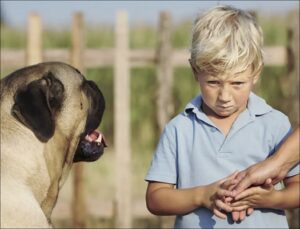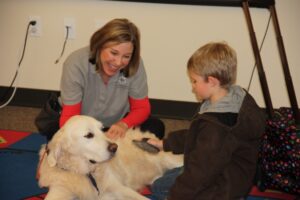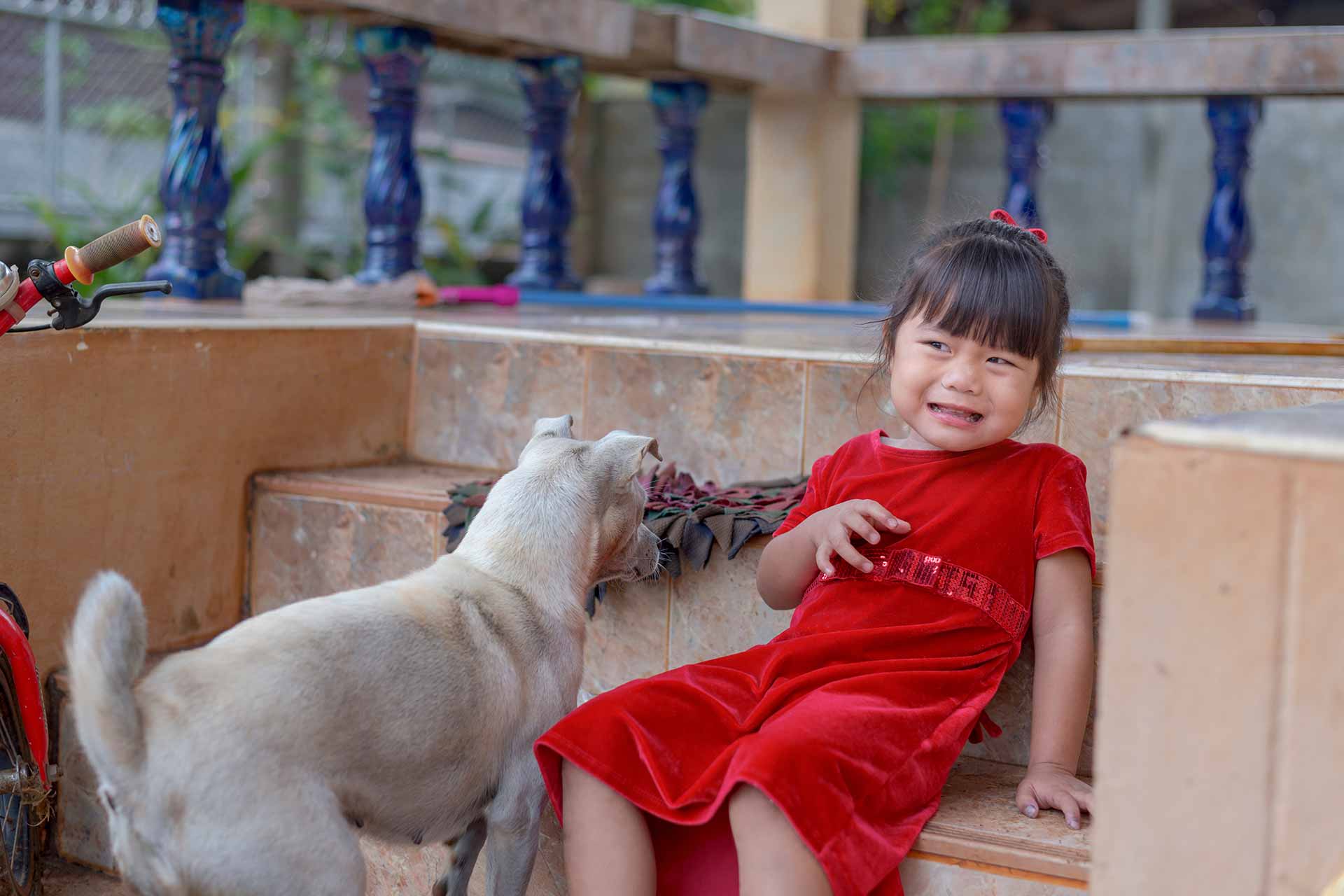It is common and part of normal child development for children to have fears. One of the most challenging fears, however, is the fear of dogs. This is true both for the children who are afraid and also for their parents. This is because dogs are everywhere! If the fear is extreme enough, it will affect many aspects of the child’s life.
This often includes daily activities such as going to a friend’s house for a sleepover, or playing at a park for fear that there may be a dog present. This often impacts the child’s self-esteem as well, because many children feel ashamed about their fear and even well-meaning people do not understand this fear or how to help a child.
As a dog trainer and retired teacher, I have seen two approaches that parents often try to use to help their child overcome this fear. These approaches can backfire and delay getting the help their child needs. I’ll go over them with you and explain why they are not effective. Then I will give you a resource which can get you on the right track from the beginning and help organize the needed steps for success. But first, let’s talk about the approaches to avoid and why.
The first approach that won’t help is try to avoiding dogs at all costs. If you have a child who is fearful maybe you’ve tried avoiding situations where a dog may be present. This won’t work in the long run because it is just too difficult to avoid dogs all the time. As I’ve stated earlier, dogs are everywhere in this country: neighborhood streets, the homes of relatives or friends, parks, soccer fields, hotels, restaurants and the list goes on and on.
The problem with avoiding dogs is that it isn’t going to help the problem go away and life will get increasingly more challenging. Another interesting thing that can happen when you avoid something is you can telegraph and inadvertently validate that there is a good reason to be afraid of that particular thing. I’ve seen this happen when people have a dog with a particular fear or even dislike of something. Generally, this fear becomes worse or blossoms into new fears.

In addition, avoiding dogs doesn’t allow the child to learn about dogs and begin to understand the animal. You have probably heard the saying, “We fear what we do not understand”. If the child can begin to understand and learn about dogs and typical characteristic traits of dogs, it can be an important part of the learning process to overcome their fear. In addition to learning about dogs, it’s also important to teach kids how to be safe around them. This is one of the reasons I am a big proponent of teaching dog body language. However, learning about something, in this case, dogs, does not mean to get a dog. This leads me to the second common approach to avoid.
With this second approach to avoid is when parents sometimes think that if they get their own dog, and it usually starts with a puppy, this will help their child to overcome the fear. Every dog comes with its own unique personality. Even within a particular breed, each dog will have its own distinct personality. It is my experience that families often choose based on the “ideal” of the breed. But in reality, there is a big range of what is considered normal. As a dog trainer, I meet with families that are struggling because they got a puppy and they did not really realize or remember that the needle sharp teeth and claws can be very unpleasant. As normal as it is, it is still no fun. Children specifically get the brunt of this typical puppy behavior and can lead to an increased fear of dogs. It’s important to do your homework before adding any dog into your family and to have a good idea of what to expect.
Children and parents are often unprepared for how to handle and navigate through various dog behavior challenges. Even adult dogs that are adopted usually come with a few negative behaviors like jumping or mouthiness. These behaviors need to be addressed before the dog can learn new and more acceptable behaviors. Most dogs are usually not very calm when you first get them and certainly not calm around children. I’ve seen children that did not have any fears become fearful or just develop a dislike of their own dog.
I’m not saying you should never get a dog. However, it should most definitely not be the first step in trying to help a fearful child overcome their fear. Resolving the fear of dogs is much more complicated than just having exposure to dogs or learning about dog body language. Digging into this issue takes a lot more thought and there are some important questions to ask.
So what are the right steps to take to begin to work through helping your child overcome their fear?
Fortunately, this last year I was introduced to a woman who recently wrote a book called, Overcoming Your Child’s Fear of Dogs: A Step-by-Step Guide for Parents. I was so impressed with this book that it inspired me to write this post. Stefani Cohen, is a licensed clinical social worker and has her own therapy dog, Fozzie. She has written an excellent, easy to follow, guide that parents, therapists and even adults who are afraid of dogs, will find helpful. The book outlines a step-by-step protocol based on exposure therapy to guide one through understanding the fear and setting realistic goals to overcome that fear.

Stefani includes questionnaires, forms, and progress charts that make it easy to understand the fear and track success. The book outlines in detail each step to be sure that you have a plan to follow and desired goals to achieve. Stefani also covers how to find and choose the right dog/handler team to help ensure a successful outcome. Stefani gives the reader some coping mechanisms for anxiety and also some mindfulness exercises. There are also great tips and suggestions to make sure you are encouraging and motivating your child along the way. There is a wonderful “I am Brave” certificate to fill out at the end of the process for the child to list all their achievements!
Stefani’s sister, Cathy Malkin, contributed to two of the chapters and helps the parent and child see from a dog’s point of view. In this way you can educate yourself and your child to better understand dogs and dog body language. Finally, the book has a wonderful resource section with books and other information on anxiety, fears, learning about dogs, dog bite prevention, how to find a therapy dog/handler and much more. She also includes my Stop, Look & Paws.
There are many reasons to help a child overcome their fear of dogs. First of all, it will help your child build self confidence and reduce anxiety. Not having to worry whether or not a dog will be at a social gathering will allow for more social interactions. If it’s the right step and your child is confident enough you may even be able to have a dog join your family. Even if you can’t add a dog to your family, your child will still be able to enjoy interactions with dogs safely and have an opportunity to develop empathy and kindness towards other living creatures.

If you are interested in buying Stefani’s book, it is available through Barnes and Noble and Amazon Amazon Book – Overcoming Your Child’s Fear of Dogs
If you would like to contact Stefani you can find her at Stefanicohenlcsw@gmail.com or Stefanicohen.com


